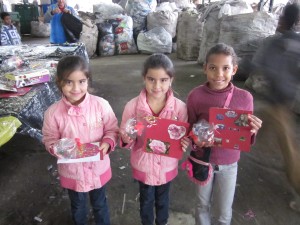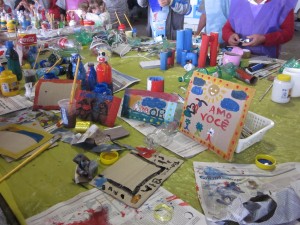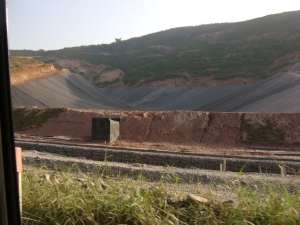Filed under: Instituto Ecoar para a Cidadania
Last week, the recycling cooperative COOPERPAC hosted an event with a daycare called Fé e Alegria (“Faith and Happiness”). The purpose was to engage the community, and its children, in the work of their local recycling cooperative.
The morning of the event, the cooperative was in a state of complete disarray–large bags covered the floor, recycling materials strewn everywhere. Not an ideal environment to bring in rambunctious kids!
By noon, the children, ages 8-14, arrived in groves. The work table was covered in several bright plastic tableclothes for arts and crafts activities, each worker wore a colorful vest indicating their group, and the floor was cleared of any sign of the disorganization apparent in the morning. The cooperative seemed to have snapped into shape instantaneously.

Each new group of children that came in were taken around the cooperative for a tour. After, they were allowed to choose from any of the fun crafts activities at the table. All the activities involved using recycling materials. They could build kites, paint soda bottle goblets, decorate shoe boxes. We all had a great time!

When I stop to think of the significance of the event–the bonding between the workers, the partnership that was made with this community daycare, and the families who would see the arts and crafts that the children would excitedly bring home–I realized that this had been our most successful day at COOPERPAC.
Filed under: Instituto Ecoar para a Cidadania
A moment I will always remember
During the week of July 18th, I took part in the Global Studies Conference in Rio de Janeiro. There I presented a paper co-authored with my advisor, Professor Ellie Perkins of the Faculty of Environmental Studies of York University in Toronto, Canada. We had written a paper titled, “International synergies to address climate change: Participatory community organizing in Canada and Brazil.”
The impacts of climate change will be especially grave for marginalized people, whose access to food, potable water, and safe shelter may be threatened due to fluctuations in rainfall and temperature, and to extreme weather events. Our paper discussed how international collaboration can strengthen community-based organizing towards climate justice, which increases the political participation of marginalized people. The idea for this paper came from our experiences working with community organizations both in Brazil and Canada. The community organizations that we discussed were Água Doce of the Baixada Fluminense in the state of Rio de Janeiro and the GreenXChange Project of the Jane-Finch Community and Family Centre.
We found that climate justice—expressly addressing the impacts of climate change on the poorest first—is a powerful imperative at every level, from the local to the global. This bottom-up movement builds resilience in the face of the social and political repercussions of extreme weather events—a global priority, since we are all in this warming world together.
Filed under: Instituto Ecoar para a Cidadania
Movement
In São Paulo, rush hour seems like it is every hour. From approximately 6am-9pm the city suffocates under the smog of the swarms of commuters that come in and out of the downtown each day. When we drive to the outskirts of the city to work with the recycling cooperatives, it sometimes takes an hour each way, or longer, depending on accidents, lane closures and traffic.
With a greater metropolitan population of twenty million people–two-thirds that of the population of Canada–and over eleven million people just within the municipality of São Paulo itself, the city struggles with a complex transportation problem. One policy in place makes every driver take her car off the road one day a week, which is called a “rodízio” or rotation. However, given that São Paulo is the financial hub of South America, those who can buy a second car to avoid the rotation!
When I was first adapting to São Paulo, I noticed how much the pollution was affecting me. In the first week, I went for a jog through our hilly neighborhood and had to stop because of unsettling pains in my chest from the smog. When there were periods without rain, the smog worsened and my eyes burned while waiting for the bus. The smell of intense car exhaust from inching along in traffic jams was nauseating. For better or worse, I have become used to the pollution and do not notice it as much. After each evening’s weather forecast, I also watch the smog and air quality forecast to see whether or not it’s advisable to bike or exercise at all outside the next day. This may be the future of increasingly dense North American cities as well.
Filed under: Instituto Ecoar para a Cidadania
Turning point

After a day at the Chico Mendes recycling cooperative in São Mateus, we went to the São João landfill (O Aterro Sanitário São João). I was simply blown away. My whole life I have been throwing away waste without knowing how cities dispose of our millions of tons of garbage.
Landfills in São Paulo are complexly designed. We took a tour of the São João landfill and also heard a talk given by an Environmental Tecnician from Eco Urbis this week at the Chico Mendes Recycling Cooperative. Each new landfill has a system of layers that are engineered so that the ground water does not get contaminated by the black water that drains from each layer of garbage. The bottommost layer of the landfill is a high-density polyethylene (HDPE), a type of thick plastic that covers the earth and does not let the wastewater enter the ground. Garbage is then added on top of the plastic cover and is compressed by bulldozers. On top of the garbage is bed of gravel and earth. Grass is planted as a cover to each landfill layer. Beyond aesthetics, the top layer of grass helps prevent landslides.
Between the layers, wastewater horizontally and vertically drains through canals that lead to massive, controlled pools. The wastewater is taken from the pools, treated and reused by the city for street-cleaning. There is also a system tubes for methane collection (released by the garbage) that goes to a nearby biogas plant, which converts the methane into electricity.
The complexity of this one landfill system is clear. I can only imagine that the city must spend an absurd amount of money constructing, designing and implenting such complicated landfills.
However, what is really shocking when touring the area is how beautiful it is. I had the impression that we were in a hilly, tropical reserve that would lead to the landfill. Our tour consisted of going around and up the first “completed” landfill hill that in twenty years could potentially become a public park. While traveling up the elegantly designed mountain of garbage, I had to question why our species had so much to throw away. Is there really no other system for our waste? Why is it that we are the only animals that need to create mountains (literally) of garbage?
Filed under: Instituto Ecoar para a Cidadania
http://tvt.vflow.tv/api/iframe/?idContent=5221&width=480&height=375.
Filed under: Instituto Ecoar para a Cidadania
Something I now appreciate that I didn’t before.
A recurring theme in this internship is the question of waste. Within the scope of working with two recycling cooperatives, we are learning about community-based recycling in the city of Sao Paulo. Eco Urbis, a Sao Paulo waste collection company, brings truckloads of recyclable goods to the cooperative centers, where members separate, sell or discard the materials. Cooperatives also have relationships with companies, schools, churches and others for the collection of their recyclable waste. The city has some of its own recycling centers, but for the most part, cooperatives are mainly located in the poorer periphery of the city and are responsible for the vast amount of the city’s recycling.
It is not easy work. At the two cooperatives I have been to, members separate the waste materials with gloves and maybe masks. Often workers have only sandals to wear in the winter. The materials they deal with can contain toxic chemicals but are usually a mix of metals, plastics, paper, styrofoam, or glass. Nonetheless, the recycling cooperatives provide jobs that support many low-income families. At Chico Mendes, the cooperative members are enthusiastic and enjoy Ecoar’s environmental education and organizing days. I look forward to seeing them every time we go.
Filed under: Instituto Ecoar para a Cidadania
Sao Paulo, Brazil
This summer–or winter, depending on the hemisphere–I have the pleasure of working at the Ecoar Institute for Citizenship (“Instituto Ecoar para a Cidadania“), an NGO based in Sao Paulo, Brazil. I received this internship opportunity through the York International Internship Program of York University in Toronto, Canada, where I am currently pursuing a Masters in Environmental Studies.
Myself and Kat Bodkin, another York student, will be working on three very exciting projects between May and August 2011 at Ecoar:
- Playing for the Environment (“Jogando Pelo Meio Ambiente“)
- Chico Mendes Recycling Cooperative (“A Cooperativa Chico Mendes”)
- Distance Environmental Education (“Educação a Distância“)
The first project involves two professional Brazilian soccer teams from Sao Paulo, Corinthians and Palmeiras. They have started an initiative to make their teams’ activities more sustainable and to reduce their carbon footprint.
Chico Mendes is a recycling cooperative that has brought together independent street recycling collectors under one roof. Each member works in a variety of roles, and at the end of the month, the cooperative divides profits with all workers.
And finally, the Distance Environmental Education project focuses on issues of Sustainability. The classes are taught virtually (on computers) to classes of dozens to about two hundred students at a time.










